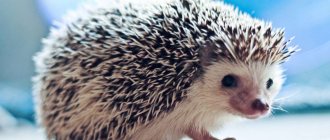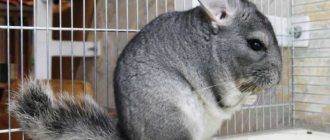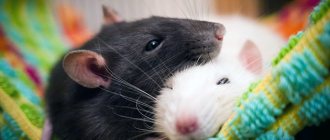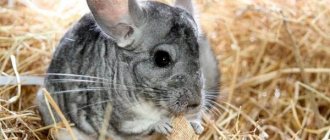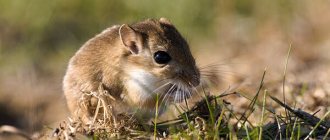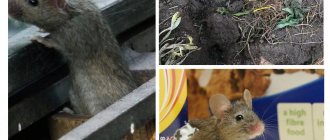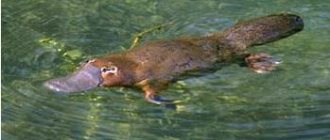How to choose a pet
Keeping pet mice does not require special care. They are clean, get used to people quickly and have a friendly character.
When choosing an animal, take a closer look at its external characteristics and behavior. A healthy animal is characterized by the following appearance:
- the fur is smooth, without bald spots, not sticking out;
- an even row of white teeth;
- eyes are moist without mucus and shiny;
- The active animal has an excellent appetite.
Don't forget that rodents live up to 4 years, so take a 12 month old mouse.
Varieties
House mice have a huge number of species. The most famous include:
- Little ones. Such rodents are the smallest mammals in Europe. They are red or brown. The abdomen of these pets is white or gray. The animals grow up to 13 cm in length. They are distinguished from other breeds by the shortened shape of their muzzle.
- Gerbils. Externally, this species resembles chipmunks. They are characterized by a short tail and a relatively large body when compared with other similar rodents.
- Needle mice. Pets of this breed may remind you of hedgehogs. The shape of their fur is like needles. It is this feature that greatly distinguishes these animals from other types of rodents. In addition, they are distinguished from other pets by the appearance of their eyes. They are black in color and have a round convex shape.
Look at the sex of the mammal
You should definitely pay attention to this, because males do not get along with each other in the same cage. They are larger than their female relatives, with a pear-shaped body.
A male 30 days old already has testicles under his tail. In females, on the third day of birth, rudimentary nipples in the amount of 5 pairs are clearly visible.
The house mouse leads a collective lifestyle, so you should buy not just one individual, but several. If you plan to breed rodents, then keep the female and male sexes separate until mating.
Reason for choosing a mouse
Decorative pet mice are an ideal option for those who have decided to have their own animal or teach a child to take care of the weak, but are limited by time, funds and square meters.
You can squeeze the mouse
Unlike phlegmatic fish - other inhabitants that do not take up much space - rodents are able to respond to affection: you can stroke them, feel the warmth of a small body in a fur coat, they are quite affectionate and enjoy sitting in your arms.
Varieties: mouse and mouse are different
Oddly enough, tamed and domesticated mice are divided into only two types. The first species is the albino mouse, also known as the white laboratory mouse. The decorative house mouse is an animal weighing on average 30 grams. with a body 7-12 cm, a tail of the same length, hard, medium-length fur, often one-color: black, brown, gray, sandy color. The lifespan of this miniature animal is on average 2-3 years.
White mouse
The white mouse stands apart - the ancestor of the entire mouse movement. Bred before our era, this creature was a frequent guest in the homes of Chinese emperors, and later, brought to England, quickly won the sympathy of all pet lovers.
In the 19th century, they were attracted to participate in laboratory experiments, as a result of which a separate species appeared - the laboratory mouse. She was bred to participate in laboratory experiments to study social behavior patterns, test medications, and much more that directly benefits humanity. For pet lovers, this species is not so attractive, although albino mice can still be found in city apartments.
Take care of the cage
- It is better to buy a large enclosure with 2-3 floors.
- It’s good if there are stairs in it - animals like to move by jumping. They will be happy to play with a small wheel and a tube.
- Mice love the process of bathing - setting up a small pool will greatly please them.
- It is permissible to use a transparent plastic box or an aquarium as a house.
average life expectancy
How many years mice live depends on environmental conditions, dietary habits, and a number of other factors. The average lifespan of mice in the wild is about three years.
Factors that reduce the population size and life expectancy of individuals include natural enemies, infectious diseases, abnormally high or low temperatures, and poor nutrition.
For example, the lifespan of decorative mice, regardless of the size of the individual, is about six years. This is easy to explain - animals kept as pets receive a sufficient amount of food and elements important for the body.
They also do not suffer from adverse weather conditions, are protected from predators and most diseases.
How to maintain and care
Sawdust or paper, corn, or straw filler is poured into the bottom of the home. The litter is changed after 3 days. In the terrarium, it is advisable to equip shelters located at different height levels and put pieces of wood for grinding down teeth.
Rodents of all types are very active, running 40 km per day in the wild. The presence of a running wheel will benefit them. Water is supplied using a hanging drinker; an ordinary saucer will do.
Unfortunately, decorative mice are susceptible to colds or overheating. Do not place the terrarium near a window and protect it from direct rays of the sun and drafts. Maintain the temperature at +21 degrees.
Note!
- Domestic hedgehog - a review of the best hedgehog breeds to keep, all the features of the pet from feeding to living conditions! + photos and videos
- Domestic goat - an overview of the features of keeping goats, how to care for them and what to feed them, as well as diseases, treatment and prevention of diseases in the review!
Sheep - learn everything about keeping sheep, features of living conditions, diet and the main characteristics of sheep as a pet!
Contents: every mouse has its own hole
Each animal needs its own special space, which it will consider “its place” - sacred and inviolable. Therefore, before you bring mice home, you should take care of where they will live. It was before, not after. Because jars and cardboard boxes are absolutely not suitable for rodents. And any move is always stressful.
Avoid aquariums as well. They are cramped, stuffy, hot, the mouse will not be able to move normally in them and arrange a secluded corner for itself. The best solution would be a spacious cage with metal bars.
Rodent cage
Be sure to make it yourself or buy a small house - a hole where the mouse will spend all day long.
Add a wheel to provide your pet with physical activity and fulfill his need for movement. For the same purpose, take care of shelves, ladders and ropes. The animal will be happy to show you its dexterity, and you will also have fun watching its amusing movements.
Sawdust for rodents
Litter is a very important element. The layer should be quite impressive - at least 5 mm. Animals use it not only for its intended purpose, but also to decorate their house, and when there are drafts or low temperatures, they burrow into it to keep warm.
The material should be natural and preferably inexpensive: sawdust, dry peat crumbs, shavings, hay. Avoid cotton wool and sand - the first absorbs odors too well and gets tangled between your fingers, and the second can become a breeding ground for lice. But something tells us that you don’t want such neighbors.
Rodent nutrition
Mammals often suffer from obesity. Owners need to know what mice eat at home.
The diet mainly consists of wheat, barley, and corn grains. No need to grind them! For small mice, a teaspoon of food per day is enough. My favorite delicacy is sunflower and pumpkin seeds. They won’t refuse various nuts either.
Vegetable and fruit additives should be present in food. Feed green vegetables: cabbage, cucumbers, zucchini, parsley. From fruits, choose apples, bananas, pears. It is rarely forbidden to pamper your pets with pieces of bread and egg whites. But don’t stuff them with smoked meats, citrus fruits, and meat.
You can get by with ready-made balanced food from the pet store. In this case, you don’t have to think about what to feed your pet mice; the only thing is that natural products are already excluded.
General characteristics of the mouse family
Science knows 519 species of rodents from the mouse family. All of them perfectly adapt to different climatic conditions, lead a similar lifestyle and have a number of identical external characteristics.
Mice can be easily distinguished from other rodents by the following parameters:
- small head with a blunt or elongated muzzle;
- large, round or barely distinguishable ears;
- small beady eyes;
- small pink nose;
- stretched body;
- thin tail, the length of which is 70-120% of the body;
- small hands of the front paws;
- hind limbs with an outstretched foot, due to which mice can jump and rise up with emphasis on their paws;
- long sharp incisors, which are located in the center of both jaws and grow throughout the life of the animals by 2 mm per day;
- hard wool, the color of which depends on the type of mouse.
The average body size of a rodent is 9 cm, and the largest mouse is considered to be an individual whose body length reaches 13 cm.
In the natural environment, many species of mice are nocturnal. Their sleep alternates with waking phases from 25 minutes to 1.5 hours. Mobile, nimble rodents move along certain routes, which can be tracked by the droppings they leave behind. The average speed of the animals reaches 13 km/h.
In the wild, mice live in small groups that consist of one male, several females and their offspring. Grown-up cubs, as a rule, are expelled from the hole.
In their natural environment, rodents hide in tree hollows, earthen burrows or grass nests. Indoors, these animals live between walls, in attics and in the underground.
The diet of most mice includes small invertebrates, foliage, flowers and plant seeds. Sometimes the animals feed on bird eggs, worms, insects and small chicks. Rodents that live in houses eat any food, and also chew soap, candles, paper and even plastic products.
All types of mice are very fertile. The female is capable of bringing up to 5 litters a year, each of which contains 8-12 pups. The pregnancy of these animals lasts on average 25 days. Until three weeks of age, the pups feed on their mother's milk, and then begin to feed themselves. After 3 months, the grown rodents are already capable of procreation.
Many species of mice cause considerable harm to people. And the most dangerous thing is that rodents are capable of transmitting the following serious diseases to humans:
- tularemia;
- rabies;
- salmonellosis;
- leptospirosis;
- Bubonic plague;
- intestinal infections;
- typhus.
Infection can occur through mouse bites, as well as through food and water contaminated by them. In addition, scientists do not reject the possibility that rodents transmit breast cancer.
Preferences and features
Chiropterans love a humid environment, so the home is equipped with several drinking bowls. In winter, individuals hibernate for a month and a half. Before this, they are not fed and are placed in a part of the compartment where the temperature is gradually lowered.
When a change in condition is observed, they are transferred to a warm place, interrupting hibernation. After it, the mice are given food in small portions.
Harm from voles
Farms, summer cottages and various agricultural organizations bear the brunt of the damage. They are massively engaged in the production of fruits, vegetables and other things. These are the places where mice are found most often.
These little rodents' teeth grow throughout their short lives, so they have a constant need to chew on something to wear down their teeth. Because of this, they gnaw the bark of trees, their roots sticking out of the ground, after which the tree becomes sick and rots. If they get into the house, they can even chew through the boards in the floors and walls, turning your house or warehouse into Swiss cheese.
Once in cellars or warehouses in winter, the mouse will eat everything there until spring, because it is very fertile for its short life.
Therefore, voles must be destroyed immediately as soon as their presence is noticed, otherwise the consequences can be dire.
But mice also bring significant benefits to people. Cosmetologists and doctors have been using mice for centuries to conduct all kinds of experiments. This is due to the extraordinary fertility of rodents and the similarity of the human and mouse genomes.
What to feed an unusual friend
The task ahead is not an easy one. His diet includes:
- mealworms;
- Khrushchevs have taken shape;
- pupae;
- mixture with milk.
The mixtures, in addition to milk, contain yolk, brewer's yeast, calcium, honey and vitamin syrups. They are poured in using a pipette.
The mouse will have to learn to eat worms from a jar on its own, but for the first time do it this way: holding it in your hands, bring the food to your mouth.
Animals are voracious, capable of eating more than their weight in food, which leads to death, so pay great attention to their nutrition.
Why is it not reasonable to have such a pet?
The house bat gets used to the hands, expecting affection. If you have not changed your decision to get one, then know:
- She remains awake during the night, flying around the room, which can interfere with the owner's sleep.
- She needs constant communication, deprived of which, she plunges into depression, expressed in the cessation of self-care.
- The need that is dealt with during the flight will soil the curtains and furniture.
- Natural food to feed it must be obtained somehow.
- In order not to ruin the life of yourself and the animal, think before taming it whether you can cope with such a task.
Description
Ornamental house rats are a domesticated form and subspecies of gray rats of the mouse family. The presence of this animal in people's lives has been observed since ancient times. There are now many new varieties of rats that have been developed. At first they were used only as experimental laboratory animals. But in modern times they began to be kept as “companion” animals.
Different types of decorative rats have different sizes, differ in the properties and color of their fur, body structure and behavior. Their peculiarity is that when even the slightest danger arises, they secrete a specific liquid that smells unpleasant and thereby scares away enemies.
The animal has thick and rather dense fur on its body.
The elongated rat face has a sharp shape, small rounded ears and small oblong eyes, which can have different colors: red, black or ruby, as well as different colors - one black and the other ruby or red. Animals with red and ruby eyes see slightly worse than rats with black eyes.
Their jaws also have special features: the upper and lower molars are closely adjacent to each other, forming dense rows. This structure allows the rat to chew food quickly and energetically.
Incisors, which do not have roots, are much longer than other teeth. They grow constantly and intensively, so the rat regularly grinds them down so that he can close his mouth. Between the incisors there is an area without teeth.
All of its teeth are unusually strong and sharp; rats bite painfully and can easily gnaw through any hard surface (brick, hard metal, concrete).
Their tail is very long: its length is either equal to or much longer than the length of the body, with the exception of the species of short-tailed rats. In almost all varieties it has no fur, but has single bristles and is covered with characteristic scales.
In nature, a rat lives either in a large community, or forming a family clan, or isolated alone. For their homes, they choose burrows left by other animals, abandoned bird nests, natural shelters, or various buildings where they rest and sleep.
Rats have a highly developed sense of smell and hearing, which compensate for their insufficient vision. They do not live long: in the wild, up to about 1.5 years. Their lifespan often depends on the type of rat. Decorative pet rats live a little longer - up to about 2 years, and with good care they can live about 4 years.
Domestic rats, along with common features with wild species, also have differences. First of all, they differ in disposition: they have less aggressive, more calm behavior. Pets react calmly to bright light. Unlike wild rats, domestic rats do not have such a pronounced tendency to be nocturnal, and in conflicts with other animals they make sounds, but not so sharply.
Photo of a house mouse
https://www.youtube.com/watch?v=pnV9AdImsh8

